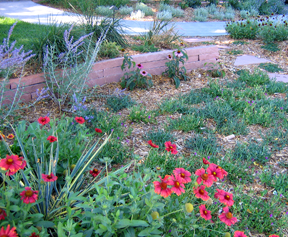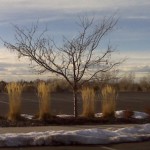by Matt Corrion
More communities are realizing that Xeriscape (low water use landscaping) makes sense, and are actively promoting it.

photo of a converted xeriscape that was previously a lawn area
The City of Aurora, Colorado and Aurora Water have been pioneers in water conservation through supporting regionally appropriate landscape design. Outdoor Design Group has been actively involved with the program for the last couple of years. For 2010, the Xeriscape Rebate program has been allocated $250,000 dollars for rebates to convert high water use landscapes (sod, turf, or lawn) to Xeriscape.
In past posts on this blog, I have documented the money and water savings and given examples of the beauty of these landscapes. Each site is different, but in general you can expect a (more…)
Related Posts:
by Matt Corrion

Brrrrr… It’s cold out there! The last thing you are probably thinking about is landscaping. Or, if you are like me you already have the itch to get outdoors and are counting the days until spring. Whether you are a restless home gardener looking for reasons to get outside, or you are performing maintenance on a commercial property and want to do all you can to have it look great some spring, there are many tasks that can be accomplished over winter. Get the hot chocolate ready!
Key Dates
- Late February: Stop any pruning from this point on- spring is right around the corner, and woody plants are developing buds and preparing for the new season.
- Late March: Plants will begin to emerge for spring at this time. As plants (especially Xeriscape plants) emerge and show signs of new growth, begin to remove any heavy mulching that was done to protect them over the winter.
Trees and Shrubs
- Apply tree wrap to the trunks of young trees, early in the winter. This protects the bark from sun-scalding and damage from harsh winter winds.
- Watch for any heavy, wet snowfall. This can break off branches of trees and do a lot of damage. Shake heavy snow from trees and shrubs that are bending and showing stress. While this can be a threat throughout winter, trees are particularly vulnerable in early spring when buds and leaves are beginning to emerge, because this creates more surface for the wet snow to stick to.
- Hand-water your trees and shrubs if dry periods persist for a month or longer and the ground is not frozen. Keep in mind that areas facing the south and west will need water more than areas with northern exposure where snow will stay on the ground longer. Water in the middle of afternoon when temperatures are warmer (above 40 degrees Fahrenheit). You only do this about one time per month, and only if dry conditions persist.
- Make sure you have plenty of mulch around trees and shrubs- this helps maintain moisture and keeps the soil from drying out over the winter.
- Finish any pruning of trees and shrubs in January. When pruning trees, look to remove branches that appear likely to grow into each other or rub against other branches. When pruning shrubs, always try to maintain the natural size and growth habit of the species. Always use the right tool for the right cut.
Perennials and Ornamental Grasses
- Leave spent stems and seed heads on grasses and perennials until spring, to enjoy their winter beauty and to provide cover for birds and wildlife. If ornamental grasses and perennials have “flopped over” due to repeated snowfall, go ahead and cut them back now to achieve a neater look- otherwise, wait until early spring.
- Late in March begin to remove any heavy mulching that was done in the fall/winter to protect the plants and preserve moisture. We usually receive plenty of precipitation in March and April in the form of wet snow and rainfall. If there is too much mulch around the base of perennials and ornamental grasses (especially Xeriscape plants with low water-use requirements) then stem rot and root rot can occur if the mulch is too thick in the spring.
Lawns
- Minimizing traffic on lawns will help to keep from damaging the grass, especially if it has been a dry winter or the ground is frozen.
Winter Weather Considerations
- January and February are the driest months of the year (in terms of precipitation) for the Front Range of Colorado. Watch soil moisture closely, and hand water your plants if you receive little snowfall. In March, the level of precipitation generally picks up quite a bit.
Other
- If you are feeding birds, try to keep your feeders full as birds can become dependant on this source of food in winter.
- If it has been a dry winter, when you are plowing or shovelling snow strategically place snow around the base of trees and shrubs to provide added moisture.
- Start planning for design changes to your landscape for summer. Now is a good time to get your plans in order, and spring is the best time to establish new plants- so get ready early, because it will be here before you know it!
- Finally, sit back and wait for SPRING! A cozy fire and a warm drink will make the wait more bearable.
This is the official blog of Outdoor Design Group, Colorado Landscape Architects. For more information about our business and our services, click here.
Related Posts:

